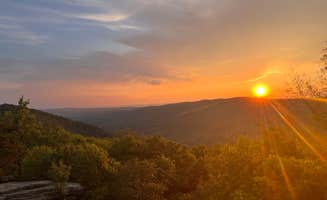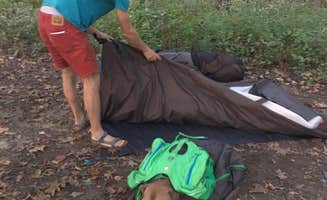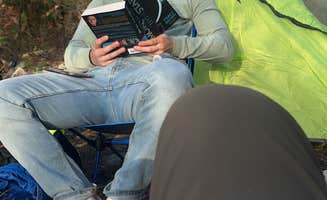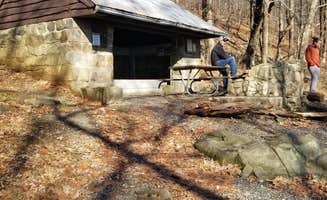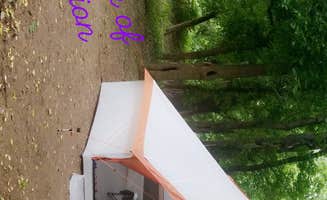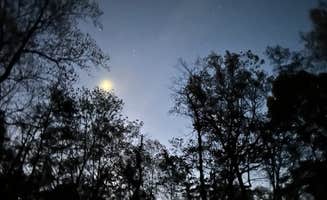Primitive camping near Harpers Ferry, West Virginia clusters around both sides of the Shenandoah Valley, with campsites at various elevations from 400 to 3,000 feet. The mountain terrain creates distinct temperature zones where spring arrives at lower elevations while snow still lingers along ridgelines. Water crossings throughout the region vary dramatically in depth from season to season, with springtime levels often reaching thigh-deep in areas like Overall Run.
What to do
Fishing at wildlife management areas: Edwards Run Wildlife Management Area offers easily accessible fishing spots ideal for beginners. "Fun place to teach the kids the basics of fishing, but the campground area leaves a little to be desired," notes one camper at Edwards Run Wildlife Management Area.
Ridgeline hiking with views: The 4-mile hike to Veach Gap rewards campers with panoramic views from established ridge campsites. "Very much worth the 4 mile hike up to the site. 1,200ft elevation difference from the trailhead to the site. Cell service at the top (not during the hike or on the road to the trailhead so prepare directions)," reports one Veach Gap visitor.
Explore Old Rag Mountain: Located within Shenandoah National Park, this challenging day hike involves rock scrambling and climbing. "It is a pretty decent hike that requires a good amount of climbing and has great views at the top. There is a bathroom on the back end of the trail but it was a little dirty. Parking is a struggle sometimes as it is a good 1 miles hike to the trail head," notes a Shenandoah National Park visitor.
What campers like
Wildlife encounters: The area hosts abundant wildlife including deer and black bears. "Two deers came to visit us at night. Killed a cottonmouth buried it since I didnt know how to properly cook and eat it. Saw Momma and two baby black bears," shares one camper at Shenandoah National Park Dispersed Sites.
Self-registration systems: Little Fort Campground offers a simple first-come, first-served system. "You select a campsite by flipping a washer on a hook on the board from green to red. Flip it back when you leave," explains a visitor to Little Fort Campground.
Seasonal transitions: Spring hiking allows visitors to experience multiple seasons in a single day. "As we descended from the highest elevation in late April, you would have guessed by the state of the trees that it was still winter. As we hiked down through the life zones to our first camp along Overall Run, a nearly 2000+ foot elevation change, the seasons changed from winter to spring!"
What you should know
Cell coverage limitations: Most primitive camping locations have limited to no reception. "This app says T-Mobile access, I'm a T-Mobile customer, no reception at all but drive 5 minutes back down the mountain and you're good to go," reports a Little Fort Campground visitor.
Payment confusion: Some sites have unclear fee structures. At Edwards Run, one camper noted: "As I pulled in there was a kiosk with a sign that said $10 camping fee but no info on how or where to pay. I tried to look at the WVDNR website but couldn't find it there either."
Weekend popularity: Free campsites fill quickly, especially on holiday weekends. "Got the last site at 6PM on the Friday of Memorial Day weekend," mentions a Little Fort visitor.
Tips for camping with families
Water planning: Many backcountry sites lack reliable water sources. "There is no water after the first mile. I have seen a small trickle part way up the mountain, but don't count on it. Pack up all the water you will need for the day/evening/morning," advises a Veach Gap hiker.
Insect preparation: Bugs can be overwhelming in warmer months. "Lots of bugs. Hiked in from the Dickey ridge trail parking lot," warns a camper at Compton Gap.
Off-road vehicle noise: Some campgrounds experience ATV traffic. "The only thing is it is next to an off-road vehicle trail and there was a lot of action coming down until about 7 PM. Wouldn't have bothered me, but it did bother my dogs," notes a Little Fort Campground visitor.
Tips from RVers
Site amenities: Designated campsites typically provide basic facilities. "The campsites have a fire ring, a picnic table, and a flat area to pitch a tent. They have parking spots next to them," explains a Little Fort Campground visitor.
Tent platforms: Some sites offer elevated platforms that require alternative securing methods. "Site had a fire pit, table, parking spot, and tent platform. Nice trails/creek behind site," notes a Little Fort camper, while another mentions: "Comes with tent pad but surface is too hard to use pegs."


